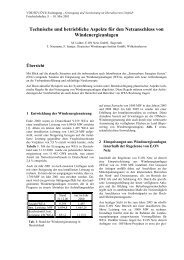controller parameters by using a decoupling filter
controller parameters by using a decoupling filter
controller parameters by using a decoupling filter
Create successful ePaper yourself
Turn your PDF publications into a flip-book with our unique Google optimized e-Paper software.
The transfer functions of the G 11 and G 22 of the decoupled<br />
system can now be presented in equation (21) and (22).<br />
G<br />
22<br />
4<br />
−3,264⋅10<br />
G11<br />
=<br />
0.05916s+<br />
1<br />
4 0.11063s+<br />
1<br />
= 4,94⋅10 0.05916s + 1<br />
(21)<br />
(22)<br />
Figure 6 shows the bode chart of the transfer function of<br />
-G 11 (blue) and G 22 (green).<br />
If the <strong>controller</strong> provides a lower gain crossover<br />
frequency than ω f<br />
the DC current control is delayed.<br />
Hence the gain was chosen to K p = -0,006 in order to<br />
exceed this limiting value for the open loop gain<br />
crossover frequency and to adapt the control direction<br />
with the negative sign. Consequently the DC current<br />
<strong>controller</strong> has the following structure:<br />
C<br />
11<br />
1+<br />
0.05916s<br />
= − 0.006 . (25)<br />
0.05916s<br />
Figure 7 shows the bode chart of the closed loop system<br />
and it can be easily seen that the system is speeded up.<br />
Figure 6: Bode chart of the transfer function -G 11 (blue) and<br />
G 22 (green)<br />
G 11 shows delay first order behaviour with a negative gain.<br />
The negative sign of G 11 is not taken into account for<br />
further studies since the control direction is simply adapted<br />
with a negative sign in the <strong>controller</strong> gain. G 22 is a PDT1<br />
element.<br />
The next two sections will show how control design is<br />
applied for the mathematically separated systems G 11 and<br />
G 22 .<br />
A. Control design for G 11<br />
Since the transfer functions G 11 is already pretty fast due to<br />
its large gain crossover frequency, it is sufficient to use a<br />
PI <strong>controller</strong>, which will handle the steady-state accuracy.<br />
The equation of a PI <strong>controller</strong> is shown in (23).<br />
1+ T s<br />
C K T<br />
N<br />
11<br />
=<br />
p<br />
(23)<br />
N<br />
s<br />
Where K p is the gain and T N is the time constant of the PI<br />
<strong>controller</strong>. The time constant of the PI <strong>controller</strong> is chosen<br />
in order to eliminate the pole in the transfer function G 11 .<br />
The gain of the <strong>controller</strong> has to be chosen in order to<br />
guarantee a certain dynamic behaviour. A limiting factor is<br />
the firing delay of 60° on average. The firing frequency<br />
can be calculated as shown in equation (24).<br />
Figure 7: Bode chart of the closed loop system C 11·G 11<br />
B. Control design for G 22<br />
As already mentioned G 22 is described <strong>by</strong> a PDT2<br />
element, which is similar to an all-pass <strong>filter</strong>. This means,<br />
that all frequencies are barely damped. Therefore also<br />
PDT2 <strong>controller</strong> can be deployed where the equation is<br />
presented in (26).<br />
( 1+<br />
TN<br />
s)<br />
s1 ( + s)<br />
C22 = Kp<br />
T<br />
N T<br />
V<br />
(26)<br />
The time constants T N and T V of the PDT2 <strong>controller</strong> are<br />
chosen in order to eliminate the pole in the transfer<br />
function G 22 and the zero respectively. Hence the closed<br />
loop transfer function is described <strong>by</strong> a delay first order<br />
element. Therefore the gain of the PDT2 <strong>controller</strong> can<br />
be chosen in order to guarantee a fast dynamic response<br />
as well as a sufficiently damped transient behavior. The<br />
gain was set to K p = 0,006. Hence the appropriate PDT2<br />
<strong>controller</strong> C 22 can be presented in equation (27).<br />
C<br />
22<br />
1+<br />
0.05916s<br />
= 0,006 0.05916s 1 0.11063s<br />
( + )<br />
(27)<br />
360°⋅50 Hz<br />
ωf<br />
= 2π<br />
= 1885rad/ sec<br />
60°<br />
(24)<br />
The bode plot of the closed loop system is shown in<br />
Figure 8. It can also be seen that the system is speeded<br />
up.





